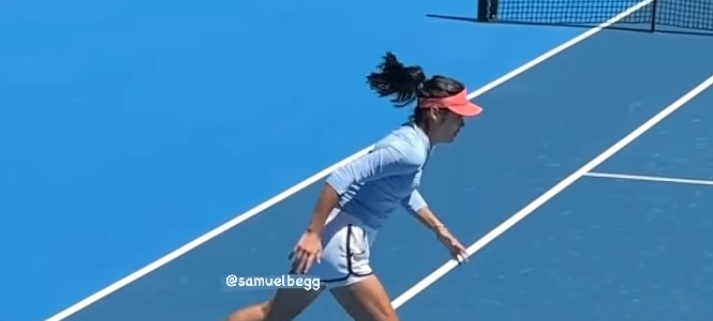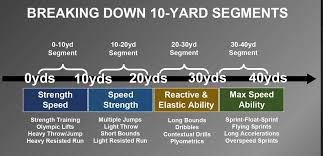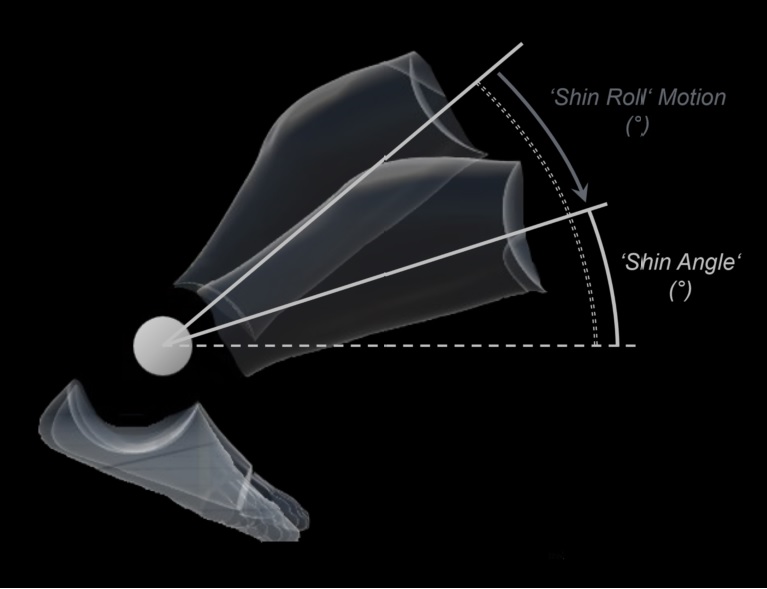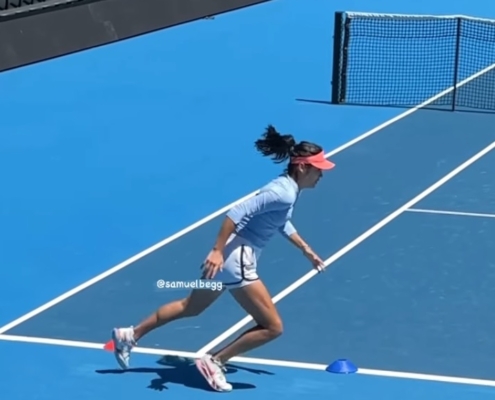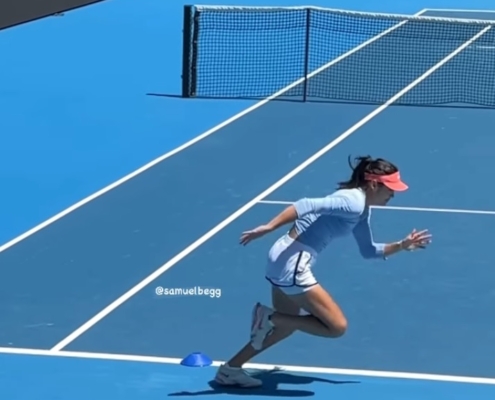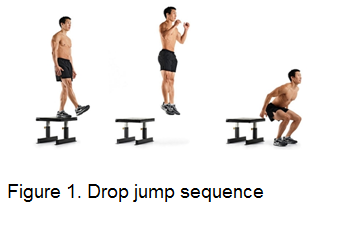Jump Profiling to Assess Acceleration Ability – CMJ or Drop Jump?
Jump Profiling to Assess Acceleration Ability
So I thought it was time to give you an update on a topic that has recently peaked my interest – acceleration. In Part 1 I introduced the background (the ”Why”) behind bounding. In Part 2 I’ll focus on the jumping drills – bounding (the ”How”). Finally, in part 3 I’ll discuss the speed drills – acceleration (the ”How.”)
This blog is a Part 1.2 if you will, because as much as I wanted to share some thoughts on bounding as a potential part of APA Method 2.0 (those methods I want to add to the existing APA Method 1.0) I also wanted to be clear that I don’t currently do much in the way of bounding, and any kind of multiple jump test isn’t currently part of the jump profile in our Fitness Test.
If I’m honest, my interest has peaked in hops/bounds because the governing body of Tennis have introduced a 3-Hop for distance test into their profiling as a means to measure force capacity, and if I am or if I am not going to introduce it, I want to have a rational.
So for this blog I wanted to cover off the current jumping profile we use at APA- and take a pause to reflect on that and what info it gives us.
Acceleration Development
For clarity, when I talk about acceleration (in Tennis) I am referring to those movements which occur over the first 1-10 metres of a court sprint. In Part 1 I made a case for emphasis on explosive movements executed with ”counter-movement‟, i.e., in the reversal yielding-overcoming (“eccentric-concentric”) regime, with the major role played by the Explosive Strength expressed in the overcoming (“concentric”) regime.
Acceleration to the ball – when first moving to the ball following the split step we’re actually not moving fast at all, but we are generating high forces. The initial acceleration to the ball requires explosive strength. Those first several strides are characterised by longer ground contact times. The more force we can develop in these first few steps, the faster we can displace ourselves. Explosive Strength expressed in the overcoming (“concentric”) regime will be a key physical quality (strength-speed).
So with all that being said, I have always felt that the Squat jump was a good proxy for explosive strength-speed. This was echoed in an interview with Matt Allen on the Pacey Performance Podcast.
First 10m – focus on non-plyometric jumps e.g., horizontal SBJ – Matt Allen (Tottenham F.C)
If you want some more insights into this have a look at my Pacey Performance Podcast Review with Cam Jose where he gives his own thoughts on the physical qualities associated with the segments of a 40 Yard dash.
As you can see, Cam mentions ”Short Bounds” as being a good training method for the 10-20 Yard segment – more speed-strength, and ”Long Bounds” for 20-30 Yard segment – more reactive strength. Given that we are focused on the first 10 Yards in Tennis what jumps might give us a good insight into the physical qualities associated with acceleration over that distance?
- Squat Jump – My thought process for having the Squat Jump in the test battery is that it may be informative when thinking about acceleration ability over 0-10m (because of its concentric emphasis)- and ability to produce power from a static start (no stretch-shortening cycle). It’s like a bodyweight proxy for strength-speed and early RFD and it’s one of the jumps that is part of the APA Fitness test battery (more on the squat jump later).
- Counter movement jump – a test of the long or ”slow” stretch-shortening cycle (greater than 250 ms ground contact time). This could be associated with most tennis movements over a few metres including shots like the running forehand where there is more hip and knee flexion and more time in contact with the ground. It’s like a bodyweight proxy for speed-strength. I see the 3 hop for distance fitting here too (slow SSC), and my thought process is that if someone is good on that test, they will probably be good at a shot like the running forehand. A CMJ could be used as an indication of 10-20m acceleration ability (and definitely braking capability but that’s not the focus of this blog). Think multiple jumps such as the triple SBJ. You are probably someone who is going to be very powerful and have longer coupling capability- meaning you are able to produce power over large ranges of motion with your hip, knee and ankle. You are probably going to dominate hill sprints, light resistance sprints. You have a lot of power against lighter resisted activities. The question is, how much more do we gain by doing a repeated jump/hop such as a 3 hop for distance, or a triple SBJ, vs, a regular single effort CMJ?
- Drop jump – This is a measure of the short or ”fast” stretch-shortening cycle (less than 250 ms ground contact time). Relevant to the split step and racket head speed on serves and groundstrokes. It’s like a bodyweight proxy for reactive-strength. Could be used as an indication of 20-30m ability.
Up until now most of my thought process has been that a test like a drop jump or the 10-5 RSI is a test more for ankle stiffness and this is a good barometer of improvement at max speeds (achieved at distance of upwards of 20m for team sport athletes). If you are improving this quality, there is a good chance you will see improvements in max velocity.
10-5 = 5 best averaged over 10 jumps.
But accelerating doesn’t take place on two legs and it seems that at the ankle at least, there may be a more reactive component related to ”ankle stiffness, ” so maybe it will benefit from a test like the RSI 10-5 jump test? To help me consider this thought process in more detail I’m going to refer to some useful insights from an article on sportsmith on ”shin roll” and its importance in Acceleration and an old instagram post from Alex Natera to give some further food for thought on this concept. I’ll finish up with some words of wisdom from Frans Bosch.
Tobias Alt
Tobias does a great job of describing ”shin roll” which is the change in shin angle (Figure 1), the shin’s sagittal motion where there is a progressive forward rotation towards the ground occurring from late swing (large shin angle) to the late stance phase (small shin angle). Check out the full article here but I’ve included a few key sections below:
Figure 1. Representative illustration of shin angle (sagittal plane angle between the shin and the ground) and shin roll. Forward rotation starts from the shin block (large shin angle) and stops at the propulsion pose (small shin angle).
This acceleration strategy is referred to as ”rotation-extension strategy”. That is, a rotation of the centre of mass around the foot in the early stance followed by a delayed and sequentially staggered catapult-like extension of the hip, knee, and ankle joint in the late stance phase. Efficient acceleration needs a degree of patience to give the centre of mass the time to rotate to avoid excessive vertical acceleration.
Figure 2. Four key positions. A: shin block, B: touchdown, C: heel lock, and D: propulsion pose are linked by a progressive shin roll motion during swing-stance phase transition. The shin’s downward tilt is facilitated by three different movement strategies: shin alignment, horizontal ankle rocker and shin drop.
Physical vs Technical Qualities
Coaches and athletes should direct special attention to the dorsiflexed ankle joint acting as fulcrum and the acceleration-specific joint angles preceding the delayed extension. This training occurs in tandem with increasing the required strength capacities of the accelerative muscles (e.g., hamstrings, gluteus medius, gastrocnemii)
Coaching Cues
After reaching the shin block position, athletes should powerfully attack the ground, like a hammer striking a nail. Subsequently, an elastic deformation by means of a well-timed horizontal ankle rocker strategy in the early stance phase might minimize braking duration and will promote the rotation of the centre of mass over the stance foot. Therefore, braking is a necessary part of the step cycle to store energy for a mechanical advantage on its return.
In linear acceleration, the ankle behaviour should no longer be associated with rigidity and minimal displacement in a short amount of time, but with dynamic elastic deformation.
Efficient acceleration requires a degree of patience to give the centre of mass the time to rotate before the delayed extension to avoid excessive vertical acceleration
.
Finally, the correctly executed application of this acceleration technique can be characterized as a horizontal bounce.
Alex Natera
The comments about elastic deformation and ankle behaviour no longer being associated with rigidity was something that Alex Natera first put me onto when he shared a single leg plyometric hop over a small hurdle and highlighted some important components of the landing phase – which includes reference to the elastic deformation.
”No matter the level, type or experience of an athlete I often “strip it back” and re-visit the function of the ankle/foot complex and ground interaction for reactive hopping, bounding and jumping. My preference is to keep it unilateral as much as possible but strip back the intensity and complexity of the plyometric activity. This allows us to zone in on pretension/preactivity, a purposely foot strike just behind the ball of the foot, followed by the locking of the ankle into tendon recoil. This exercise is often a warm up before the main event.’‘
This got me thinking and I noticed that in a lot of videos and images I was watching of tennis players I was observing this tendency for the foot strike with the mid/forefoot followed by a heel to hit the ground after the initial touchdown, what Tobias referred to as the heel lock, and Alex referred to as an ankle lock.
Below is a series of still images of a pro player executing an acceleration across the court (right foot- left foot- right foot). I know it’s not the same limb but in image 1 (right foot) you can see the initial mid/forefoot strike and in image 2 (left foot) I’ve captured the heel lock.
Wise words from a elite sprint coach
Speaking to a former elite sprinter and now coach at this year’s UKSCA conference, he said that we have to remember that ”the progression from acceleration to maximum velocity is a continuum and changing situation every step. Also the GCT of acceleration steps are longer than max velocity – but still aren’t very long – and are even shorter when already in motion like many field sports will be. They are shorter then a double leg – pogo which is the fastest of the plyo activities in terms of GCT. (Daz comment – I seem to recall the first step of acceleration out of the blocks being around 0.5 seconds but that quickly drops to 0.2 seconds by the second step).
Ankle stiffness in acceleration vs. max velocity – depends on how you view and define this stiffness. If stiffness means little movement then in max velocity there is a lot more than in acceleration. In acceleration the ankle should produce high levels of stiffness to maintain the angle of foot strike and therefore shin angle at ground contact. This then shifts towards a move ‘compliant’ ankle for max velocity where the elasticity component plays its part in allowing a rapid flexion of the ankle to get the rapid recoil back from the tendons and fascia of the foot, calf and ankle complex.”
Perhaps an argument could be made for the drop jump then – because of the elastic deformation by means of a well-timed horizontal ankle rocker strategy in the early stance phase and to minimize braking duration (so a quick transition from heel lock to propulsion?) When I put this to the elite sprint coach he said ”DJ and 10-5 will absolutely be useful for assessing physical qualities needed for acceleration – it’s all explosive and fast movements – and they are tests that might relate that tiny bit more – yes – but unless you are working with high level sprinters then its probably not a differentiation that is required to be made.”
To me this all sounds like the juice isn’t worth the squeeze in terms of switching from a SJ vs. CMJ comparison to a CMJ vs. DJ comparison for tennis athletes. You may not share that opinion, and if you’re keen to use the DJ I’ve included further information below on how to interpret the jump profile data.
Furthermore, this doesn’t mean I won’t be programming drop jumps as part of a comprehensive jump training curriculum, only to say that I’m satisfied that measuring SJ vs CMJ still gives me enough insights into how well a tennis athlete uses their slow SSC- and in my opinion that is where most of the tennis actions live so it’s a valuable metric to monitor. Finally, I think its incredibly important to prioritise calf strengthening as it seems that there can only be good things to come from doing that, and I’ll touch on that at the end of this blog.
Measuring Jump Performance
In 2006 I read Eric Cressey’s Ultimate Off-season Training Manual where he spoke about the static-spring continuum in the context of athletics.
- If you’re a “static” athlete (think powerlifter), you’re very strong, but lack reactive ability. Your training needs to focus on initiatives (“plyometrics,” although it’s not the best term for what I have in mind) that prioritize reactive ability: your ability to effectively make use of the stretch-shortening cycle. Doing so will condition the nervous system and musculotendon unit to better store elastic energy and use it for subsequent muscular action.
You may or may not need to prioritize rate of force development (RFD, or explosive strength), which is your ability to develop force quickly. If you have tremendous strength, but cannot develop it quickly, that strength is useless in athletic contexts.
- If you’re a “spring” athlete (think of a basketball or volleyball that just runs and jumps all day, but never lifts weights), you’ve got good reactive ability, but lack maximal strength. Your training needs to focus on “lifting heavy stuff” to make your “maximal strength glass” bigger.
Eric Cressey recommended using a comparison of countermovement jump versus drop jump. The countermovement jump is a test of the long stretch-shortening cycle (greater than 250 ms ground contact time). Do that first. Next, grab that 12-inch box and place it on the ground about 6-8 inches away from your “takeoff” spot for the jumping tests. You’re now going to do a bounce drop jump; this requires you to step – not jump – off the box, and upon landing, spring right up into the vertical jump test.
The idea is to minimize ground contact time as much as possible; you really should “bounce” instead of just doing a “landing and jump.” Attempt to use the energy you take in to facilitate the force you put out. This is a measure of the short stretch-shortening cycle (less than 250 ms ground contact time).
Interpreting Jump Results
CMJ vs Drop jump
If your bounce drop jump from 12” is less than your countermovement jump, you can stop the test; it’s a sign that you’re using too much static and aren’t able to use the spring because you lack reactive ability. However, if your bounce drop jump is equal to or greater than your countermovement jump, move to an 18-inch box and see what happens. If the jump height goes up, keep increasing the box height by six inches at a time until your jump height fails to improve. In doing so, you have not only established that you’re very spring-proficient and need to train maximal strength more; you’ve also determined the optimal height for future depth jump training: the height that maximizes power output (jump height).
If you find that your bounce drop jump is less than or equal to your countermovement jump, you need to prioritize
reactive ability; you’re not able to efficiently take in energy and use it for subsequent force production. If your bounce drop jump – regardless of the box height you reached – is 20% or more than your countermovement jump, you need to prioritize maximal strength. The closer to 20% it is, the more maximal strength you need. The closer to 1%, the more reactive training you should do.
CMJ vs Squat jump
As I stated earlier in the blog, I’ve often thought that acceleration is all about concentric force production (definitely in the powerful quadricep and glute muscles) so the squat jump would be a proxy for leg power in the initial 0-10m acceleration phase and the counter movement jump would be a proxy for higher speed explosiveness over say 10-20m.
Most athletes are generally able to jump higher when performing the CMJ versus the SJ, meaning an athlete has an adequate use of the stretch-shortening cycle to store and release energy. Historically, when I have seen an athlete have a minimal difference in squat jump height and countermovement jump height I’ve used that as a indicator that the athlete is not very proficient at using the SSC – and needs to perform a greater proportion of plyometrics in their programme. But not so fast!!! There is another interpretation. It could also mean they are a very good athlete at producing early RFD- and ability to produce force in small amplitude of movements. This could include ankle stiffness at max velocity (and I’m now making a case for the foot strike during acceleration!).
Due to the differences between a squat jump (no downward momentum and/or limited SSC utilization) and the countermovement jump (downward momentum and SSC utilization), the tendon stiffness utilized becomes more apparent. Therefore, as proposed by Bas Van Hooren and Frans Bosch, a better indicator of abilities to reduce muscle slack, and therefore produce a higher magnitude of early rate of force development, would be highlighted by a minimal difference in squat jump height and countermovement jump height.
However, if the countermovement jump is much higher than that of the squat jump, it may indicate that an eccentric preload is required to take up the slack of a compliant tendon that would otherwise not be readily taken up during a squat jump. Thus, a compliant tendon and an increase in muscle slack would mean a lower rate of force development, a longer time to reach maximal force, and a larger difference between countermovement jump height and squat jump height.
Do we want more stiffness or more compliance?
I think I’ve already made my opinion clear that for Tennis I think having a more compliant tendon is okay because the majority of tennis actions afford more time in contact with the ground. Any work we do at the calf to develop more tendon stiffness is going to show itself in a drop jump improvement but not necessarily in a CMJ, so we need to bare that in mind (see more below).
A stiffer tendon may allow for force to be quickly transmitted from the muscle to the connecting structures to produce joint motion by reducing the need to take up the slack, which would otherwise be present with a compliant tendon. Therefore, a stiffer tendon may allow for quicker, more efficient transmission of force compared to a more compliant tendon and therefore, possibly greater rate of force development. These improvements are critical for rapid, and efficient transfer of force through the SSC.
A study by Burgess and Colleagues evaluated the effectiveness of drop jumps and calf raises in regard to improvements in tendon stiffness. In the study, isometric single leg calf raises, increased tendon stiffness by 61.6% compared to only a 29% increase in stiffness from single leg drop jumps. Combining these findings with those of Kubo and colleagues and the evidence clearly highlight the potency of isometric at improving tendon stiffness.
Magnitude versus Rate – It is important to note an increase in stiffness might not increase countermovement jump height. This is possibly due to the fact an increase in tendon stiffness will not increase the magnitude of force being expressed in large amplitude movements. Large amplitude movements allow for a longer duration for the muscle to reach maximal force and thus, the rate at which force is produced plays less of a role, especially early stage rate of force development. As proposed by several experts, the downward velocity created by a countermovement may act to pre-load the tendon of the jump, thus taking up the slack and masking the negative effects of the compliant tendon.
Therefore, a stiff tendon may simply play a role in quicker transmission of force from the muscle to the tendon, which is why it may not have much influence when force is able to reach its maximal, such as large amplitude movements where ample time is provided for force development, similar to that of a full depth countermovement jump.
It is important to note that early and late-stage rate of force development are two independent qualities. Rate of force transmission from the muscle through the tendon is most likely predicated on early-stage rate of force development, which appears to be comprised of both neural firing rates and as suggested by the above evidence, tendon stiffness. However, early-stage rate of force development will not directly influence the amount of force being produced in movements with ample time for force to be developed. Therefore, one should not expect tendon stiffness to increase performance of large amplitude movements with large loading times.
However, early-stage rate of force development does play a role in situations where time is limited, such as the squat jump. A countermovement jump has been shown to take a long enough time for maximal force to be developed, with the time of movement lasting roughly 0.5-1 second. However, a squat jump may take only 0.3 seconds to execute. Thus, the small time frame does not allow for maximal force to be reached and therefore relies more on early stage rate of force development, hence the improvement in squat jump height but not the countermovement jump height.
As argued by Frans Bosch, most typical sporting movements have to occur over a short period of time, with small amplitude of movement. Therefore, early-stage rate of force development may play a more critical role in sporting movements as opposed to lab-based, controlled jumping exercises. Proper training should not only increase the magnitude of the force that can be developed and transmitted, but also the speed at which it can be developed and transmitted. To increase the rate at which force is transmitted and early rate of force development, a stiff tendon may be necessary. Thus, isometric training may vital for developing these critical tendentious adaptations, as well as more reactive forms of plyometrics such as drop jumps.
My Verdict on Best Jump Profile for Tennis
I’m sticking with the CMJ. I didn’t address it here but I think the triple SBJ or even the 3 Hop for distance still fall in the same part of the Force-Velocity curve (slow stretch-shortening cycle). I’m putting the SJ as a bodyweight proxy for strength-speed and the CMJ, triple SBJ and 3 hop for distance all as a bodyweight proxy for speed-strength.
There is a skill element to the multiple jumps and that can be a good thing but in my opinion also introduces further ”noise.” At the end of the day I just want a proxy for how well the athletes use their slow SSC. I’ll train the ”fast” SSC as part of our jump training curriculum, and I can always measure drop jump performance as part of the training, particularly when I am going after some adaptations at the calf complex.
Hope you have found this article useful.
Remember:
- If you’re not subscribed yet, click here to get free email updates, so we can stay in touch.
- Share this post using the buttons on the top and bottom of the post. As one of this blog’s first readers, I’m not just hoping you’ll tell your friends about it. I’m counting on it.
- Leave a comment, telling me where you’re struggling and how I can help
Since you’re here…
…we have a small favor to ask. APA aim to bring you compelling content from the world of sports science and coaching. We are devoted to making athletes fitter, faster and stronger so they can excel in sport. Please take a moment to share the articles on social media, engage the authors with questions and comments below, and link to articles when appropriate if you have a blog or participate on forums of related topics. — APA TEAM

